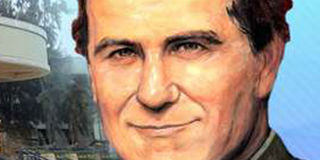Catholic faithful to witness enthronement of Don Bosco's relics

A picture of Saint John Bosco, popularly known as Don Bosco, from a banner of his relics. He is the founder of Salesian Missions. COURTESY
What you need to know:
It has been a long-standing tradition in Christianity to honour objects related to individuals who had lived exemplary lives. Early Christians held in veneration the remains of martyrs who had shed their blood for their faith.
The mortal remains of saints and objects related to them are referred to as “relics”.
The habit of honouring the relics of holy men and women continues to this day among many Christians, particularly in the Catholic tradition.
Catholic faithful will on January 29 congregate at Nairobi’s iconic Don Bosco Catholic Church in Upperhill, Nairobi after a procession from Nyayo National Stadium to witness the enthronement of the relics of St John Bosco, popularly known as Don Bosco.
It has been a long-standing tradition in Christianity to honour objects related to individuals who had lived exemplary lives. Early Christians held in veneration the remains of martyrs who had shed their blood for their faith.
The mortal remains of saints and objects related to them are referred to as “relics”. The habit of honouring the relics of holy men and women continues to this day among many Christians, particularly in the Catholic tradition.
The veneration of saints goes back to the first century of the Christian era. It has two major aims: first, it begins with an admiration of how the individual has exceptionally responded to the grace of God. It draws the faithful to a sense of the sacred. Therefore, in honouring the holy person the Christians challenge themselves to imitate the exemplary life of the saint. Secondly, they also believe that this saint is capable of interceding for them in mediating the grace of God.
PUBLIC VENERATION
In recent memory, the Catholic Church in Kenya has had the public veneration of relics of some saints. Many Kenyans might recall the beatification of Sister Irene Stefani Nyaatha that was held in Nyeri in 2015. Around this celebration, her remains and the things that she had used were also placed in the church at a place of honour. A few years ago, the relics of St John Bosco were on a tour around the country, so also was the walking stick of St Teresa of Avila, a 16th century Spanish mystic.
The premises of the Shrine where the event will take place also house the headquarters of the Salesians of Don Bosco in East Africa.
The Salesian priests and brothers, belong to a religious order that was founded by St John Bosco in Italy in the 19th century. They are a group of men and women, numbering almost 30,000 — spread across 135 countries — engaged in ministry to young people. In Kenya, they run academic and technical schools, youth centres, welfare activities, and rehabilitation facilities for children in need in over 20 centres. Their presence right inside the refugee camp at Kakuma, Turkana County, is noteworthy.
LITTLE HAMLET
Don Bosco himself was born in a poor background in a little hamlet near Turin, Northern Italy, in 1815. Incidentally, he hails from the same village as Blessed Joseph Allamano the founder of the Consolata Missionaries, the stalwarts of Catholic evangelisation in Kenya.
After much struggle, Don Bosco reached his vision of becoming a priest in the Catholic church in 1841. Those days, Turin was one of the fast-growing industrial cities in Europe. Drawn by the lure of the city, multitude of young people were pouring into Turin. Like what happens in African cities of today, the youngsters had no jobs, no food, no place to sleep. They ended up in prisons for petty crimes.
The young priest Don Bosco used to visit prisons and noticed that they were full of young people. He wanted to do a preventive educational work and started gathering the boys in the streets for prayer and instruction. Later he established shelter homes that also offered trade-skills in order to empower them have better opportunity in the industrial city.
Even as Karl Marx was composing his Communist Manifesto and Charles Dickens was writing his novels Oliver Twist and David Copperfield, about boys victimised by Industrial Revolution, Don Bosco signed contracts with employers on behalf of his boys. Long after the death of their founder on January 31, 1888, the Salesians of Don Bosco continue his mission for young people across the globe.
SPIRITUAL EXERCISE
Marking the bicentenary of the birth of Don Bosco, between 2009 and 2015, the Salesians of Don Bosco carried out a spiritual exercise. They made three replicas of the statue of St John Bosco in repose encasing some bones from his right arm. These statues were taken in pilgrimage across the globe to over 100 countries. One of them even visited Kenya towards the end of 2011. Now, however, one of these three statues will find a permanent home at the Shrine of Mary Help of Christians at Upperhill, Nairobi. It is this statue that the Catholic faithful will on January 29 take in procession from Nyayo National Stadium to the Upperhill Church to be enshrined there. Large crowds, including bishops and church dignitaries, are expected to attend this devotional event and there could be traffic disruptions.
It is hoped the event will motivate Christians to emulate the example of Don Bosco in reaching out to the underprivileged youth of Kenya.
Sahaya G. Selvam is a Catholic priest and associate professor of psychology, Tangaza University College.




